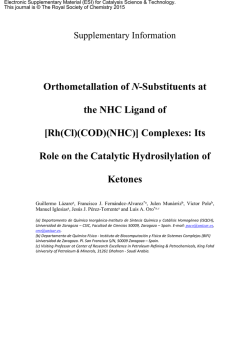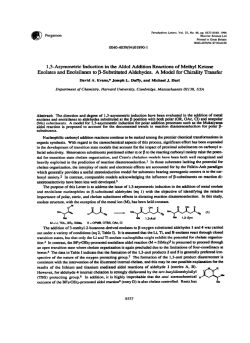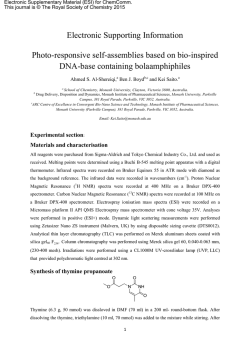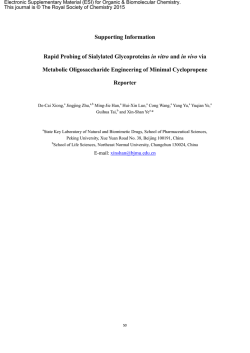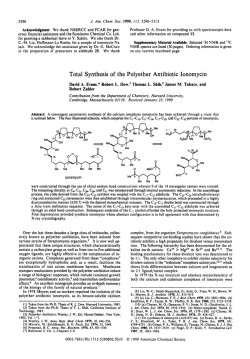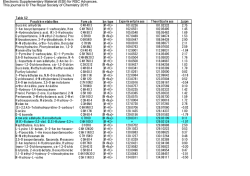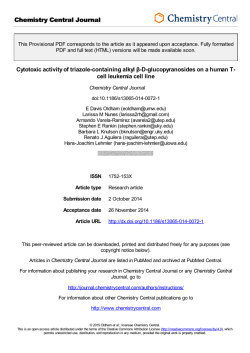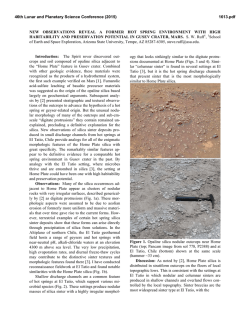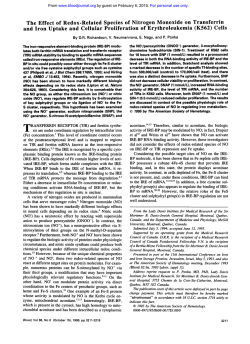
~iaster~selective A~~~ Aldo1 Reactions of Choral Ethyl Ketones
~ TevohrdronVol. 48,No. 11,pp.2127-21421992 Printedin GreatMain Q $3.00+*00 1992PagamalPmsp~ ~iaster~selective A~~~Aldo1 Reactions of Choral Ethyl Ketones. Enantioselective Processes for the Synthesis of PoIypropionate Natural Products. David A. Evans,*HowardP. Ng, J. Stephen Clark,and Dale L. Rieger (Receivedin USA 19 October 1991) Key Words: S~sclcctive uti aldoireactions; Bketo imides; (E) boron enolates; polypmpionate synthesis. A~‘fhediesterplwekrtivemrtialQlreauionsof~~iieto~~3a,tbenLitedethylketoneMb. audits&-22bhavebcenstudied. IntheseaMolrractions,~thedtirale~ylketonas~aMi2ObwaefoMdtocxhibittheqrposite~ofasyrnmetricinductionintheaoalogwsMn’aMolbondcurstructionsfromtbedaived(E) boron~IILWS. The ielevanccof thisstudyto the synthesisof polyptopiaute naturalpmductsis discussed. Iiitroduction The polyketides are an important family of naturally occurring substances which include antibiotics, ionophores, immunosuppressive and antitumor agents, and other bioactive materials of widespread importance in chemotherapy. The in viva synthesis of these substances conforms either wholly or in part, to a variant of 2127 2128 D. A. EVANSet al. the theme represented in fatty acid biosynthesis wherein either acetate or propionate constituents are assembled through a linear series of acylation and intervening refunctionalization operations.* The erythromycin antibiotics provide one ofthe best illustrations ofpolypropionate assemblage where the sole carbon source for the macrolide portion of these structures is derived from propionate. In contrast to the motif expressed in erythromycin biosynthesis, the biosynthesis of the polyether antibiotics* such as lonomycin A3 involves the incorporation of pmpionate as well as acetate and, on occasion, other low molecular weight carboxylic acid building blocks. Lonompin A (emeticid) CT&~. Bpqionate subunits In the most tecent model4 for the assemblage process leading to the biosynthesis of propionate-derived natural products, methyl malonyl CoA, under the action of a polyketide synthase (PKS), is acylated by a starter thioester fragment installing the fiit propionate subunit and associated stereogenic center. In the subsequent events culminating in the completion of the first cycle, the acylation adduct is reduced, either partially or fully, and the new thioester readied for the next cycle (Scheme 1). The multienzyme complex associated with these two sets of transformations is referred to as a synthase unit (SU). Recently, the genes which govern the synthesis of the eryduomycin macrolide have been identified.4 Scheme 1.Primary Steps inPolyptopionate Biosynthesis: Two Synthase Unit Cycles. Our interest in utilizing the primary steps in polypropionate biosynthesis as a stimulus for the development of analogous laboratory transformations originated with the observation that the primary biosynthetic acylation event could be effected to afford 1 whose newly formed 2’ methyl-bearing stereogenic center could he retained during the course of a standard chromatographic purification (eq 1): An X-ray structure of 1 diastereoseiection 97:3 Figure 1. X-ray structure of g-ketoimide 1 kq 1). J Aldol Eactions of chiral ethyl ketones 2129 (Figure 1) suggested that the unexpectedly low kinetic acidity of 1 wasmost likely due to allylic strain conformational effazts which orleat the C-2’ hydrogen in a conformation not conducive to overlap with the C-l’ carbonyl moiety. The preceding observation suggested that one might exploit ~~1 imides such as 1 insubsequent aldol bond constructions to provide the s&duct2 (eq 2), the penultimate intermediate in dw: second iteration of the synthase unit (Scheme 1), if mild, kinetically controlled enolization conditions wete employed. If this aldol methodology could be coupled witb the appropriate stereoselective reduction.&7 of 2, one might then have a powerful set of bond constructions for the rapid assemblage of polypropionate natural products, For example, the application of both the Ti(IV) and Sn(II) aldol reactions illustrated below (eq 3, 4) to the that the oxidation pattern found in the synthesis of erythmmycin is readily apparent. It is also n~wo~y lonomycin A Ct-Q carboxyl terminus (v&e sypra) conforms to that found in aldol adduct 2. and we have recently reported the application of this concept to the synthesis of the C&t polypropionate Rgion of this polyether antibiotic.8 n Two stsps;fournew steretmntem inco~tsdinto ROHO of the four possible stereochemical variants of this basic bond constmction, we have been able to develop the two syn aldol options shown below (eq 3,4).9 The subject of the present study is the development of one ofthetwo remaining anri aldol options (eq 5), Results and Discussion Synthesis of PKetoimide Substrates. The diastereomeric B-ketoimides 3a and 3b used in the study were prepared according to the two general methods previously rqotted (eq 7, g).” For the preparation of 3a, the aldol adduct 4?* synthesized from (R)-5, was oxidized by the method of Par&h and Doerit@ to provide a 95% yield of the crystalline imide 3a. Alternatively, the diit acylation of the magnesium enolate derived 2130 D. A. EVANSet al. from (R)-5, with propionyl chloride (1.05 equiv) provided the expected diastemomer 3b in 78% yield with kinetic diastemoselection of >20:1. Prior studies from this laboratory9 had established that, although the dominant stereogenic center in the enolates derived from either 3n or 3b is the methyl-bearing center, some modulation of the reaction diastereoselectivity by the stereogenic center on the chiral auxiliary was noted in both the Ti(IV) and Sn(Il) syn aldol reactions (eq 3.4). Although a detailed explanation is still not possible for this subtle stereochemical bias, the observation that 3n was consistently more d&mmoselectlve than 3b in the complementary syn aldol processes provided the impetus for initiating the present study with the former substrate. Subsequent control experiments (vidc i&a) now suggest that the effect of the remote center on the chiral auxiliary is minimal in at least one of the anti aldol processes (eq 5). /3-Ketoimide Aldol Reactions. The recent report by Brown12 on the stereoselective generation of(E) enolates using the dicyclohexylchloroborane-triethylamine enolixation procedure farmed the basis of the pmsent study on the enolixation and aldol reactions of &ketoimide 3a. This substrate and the maction of its derived (S’) boron enolate with isobutyraldehyde provided the focal point for maction optimization studies. Not surprisingly, the outcome of this reaction is quite dependent on the solvent and amine used. As re ported by Brown, diethyl ether proved to be the solvent of choice. Reactions performed in tetrahydrofumn or toluene resulted in lowered yields and selectivities while no reaction was o&rved in dichloromethane. A systematic variation in amine structure did not affect reaction diastereoselectivity but had a marked effect on product yield. The optimum amine was found to be NJ+dimethylethylamine. Triethylamine and Nethylpiperidine afforded lower yields, while di-iso-propylethylamine, 2,6-lutidine, and secondary amines failed to effect enolixation. In addition, product isolation conditions employing activated IRA-743 resin13 to remove the boron contaminants ptoved superior to either the usual oxidation procedures using aqueous hydrogen peroxide or axeotropic methods using methanol for removing boronates through co-distillation. Epimeri&on of the Q-center and/or loss of chiral auxiliary were observed rvhen the latter two methods were used. Figure 2. X-ray structureof aldol sdduct 6a (eq 9). 2131 Aldol reactions of chiral ethyl ketones Using the preceding reaction conditions for the form&on of the Q enolate of 3a (c-b&BCl with NJ+ dimethyletbylamine (Etzo, 0 ‘C, 1 h), the subsequent aldol reaction with isobutyraldehyde (-78 “C. 3 h), afforded the crystalliner#i-ann’ akiol adduct 6a in 78% yield accompaniedbytheotherfzdi3ldoladduct7aine which had been previopsly cbaracterratio of 84:16 (eq 9). The other two possible reaction diastmomas. ized,g were not observed thus indicating that tbe reaction Mbited a bigh level of& al&l diasteteoselection. The structure of 6a was detem&ed by X-ray crystallographic analysis. The complementary aldol reaction was also canied out on the diastemmetic ~ketoimide 3b with essentially the same stereochemical outcome and reaction diastereoseleztivity (eq 10). The major and minor aldol adducts, 8a and 9a, respectively were purified by chromatography on silica gel and con&ted with the aldol adducts 6a and 7a derived &om fitoimide 3a (eq 9) by triethylamine equilibration (CHzCl2,25 ‘C, 3 h). In this comparison (Scheme 2), the major product diastneome r 8a derived from 3b, upon epimerization, pm vided a new aldol diastereomer which proved to be identical with the minor product diastereomer 7a produced in the aldol reaction of the diastereomeric kketoimide 3a. In the analogous cor&ation, the major aldol diastereomer 6a derived from 3a. upon epimerization produced an aldol diastereomer which was identical with the minor aldol diastereo~ 9a pmduced in the aldol reaction of the diastereomeric B_ketoimide 3b. These experiments thus provide a correlation between the aldol diastereomers of 3a and 3b and establish that the C-2’ stereocenter is the dominant control element in the aldol reactions of both subshates. -h 3b & #a (74%) dias- Scheme 2. Base tW17 3b. The generality of the aldol reaction of 3a was then evaluated with a variety of representative aldehydes (eq 11. Table I). In the instances studied, the isolated yields of major diasm ranged from 70-845 with fair to excellent reaction diastereoselection. It is noteworthy that the aldol reaction provided in entry E is a matched double stereodifferentiating process; and in accord with expectation, this process is significantly more diastereoselective than its achiral counterpart (entry A). With the stereochemical assignment of aldol adduct 6a secured by X-ray crystallography (FQure 2). the absolute configumtions of tbe nmaining adducts 6b-6e were assigned by analogy. The sense of asymmetric induction observed in these reactions (eq 11) was unexpected and opposite to our u priori prediction based on a reactant-like transition state model wherein A( 1.3) allylic sti confcnmational considerations14 would dispose the methyl and RL substituents in the manner illustrated below. 2132 D. A. EVANSet al. The assumption that the ZV-propionylimidaxoyl moiety (RL) is sterically more demanding than the methyl substituent appears to be reasonable. This conformational model leads to the clear prediction that the si face of the enolate should be more accessible to attacking ekctrophiles, thus leadiig to the conclusion that the rynanti aldol d@mmomer would be the majoraldol product (eq 12a). The fact thatthese reactions proceed with the opposite sense of asymmetric induction to @ord the anti-anti diastereomer (eq I2b) convincingly invalidates this naive postulate on the geometry of this aldol transition strncnue. This point will be revisited later in the discussion. Table I. Anti Aldol Reaction of 3a with Repmsemative Aldehydes (eq 11). 84 : 16 A B ocH-aw=q C ~-C&C& D 72 NW OQIacIEsh 92:a 70 (6c) c ao:m WWc 88: 12 97:3 ’ Values refer to isolated yield of major diaemuner bRatiosdetermmcdbyHFW. 6, unless otherwise noted, CYieldofpurifiedmixtumofdia@mom era. d The enantiomtic purity of this al&&de was 98%. favored 7 0 I R +l Me syn-anti diastereomer Me OH R+ Meh R uw anti-anti diastereomer Stereoselective Reductions. The stereoselective reduction of these aldol adducts is invariably a necessary adjunct to their utility in polypropionate synthesis (Scheme 1, eq 2). Not unexpectedly, the reagent of choice for achieving either syn6 or anti7 reduction of a given syn or anti aldol diastereomer in this general series of compounds is not always the same. With the present set of aldol adducts, exemplified by 6a, selective anti reduction (>99:1) to 11 can be achieved with either NaRH(OAc)j or MwH(OAc)j (eq 13).@ Aldol reactions of chiral ethyl ketones 2133 On the other hand, reduction of 6a to the diastemomeric syn diol12 is less straigbtfo~~ard.It was observed that Zn(BH.&, the optimal reagent, exhibited modest syn selectivity (l2:114:1,89%). In a complementary procedure, reduction with EtZBOMe/NaBHqts resulted only in decomposition of starting material. Surprisingly, reduction of 6a with DIBAL-H, a reagent known to afford syn dials in ntmrerous instances,t6 afforded predominantly the anti diol 11(>92:8), in 73% yield. The stereochemical assignments of dials 11 and 12 were made through the respective acetonides 13 and 14 which were subjected to homonuclear decoupling, NOE, and 1% NMR spectroscopic studies. The coupling constants and nuclear Overhauser enhancements reveal that acetonide 14, derived from syn diol12, exists in the expected chair conformation. On the other hand, nuclear Overhauser enhancements of acetonide 13 indicate that it is in a twist-boat conformation. The 1% resonances of the ketal and methyl acetonide carbons of acetonide 13 are 25.2, 23.3, and 100.3 ppm, indicative of an anti diol-derived acetonide.17 Similarly, the corresponding t3C!resonances for acetonide 14 are 29.9.19.0, and 97.8 ppm, confirming the complementary syn diol relationship. 14 J (t-&-l+)= J&-H,) = 10.0 Hz Anti Aldol Reactions of Related Chit-al Ethyl Ketones. The sense syn aldol reactions such as 15 has now been established in a number of instances for both boron and titanium enolates bearing a wide array of sterically dominant substituents, RL.‘* Furthermore, transition state models have been proposed by both us’& and Patersonts to rationalize the sense of asymmetric induction observed in these processes. With the exception of the Sn(II) aldol reaction recently reported by us (eq 4),9 and a lithium enolate aldol reaction reported by M~Carthy,*~ the syx aldol reactions conform to the stereochemical outcome shown below. In contrast, there is little precedent for the sense of asymmetric induction which might be expected for the analogous anrialdol reactions of the analogous (E) enolates (eq 15) with the exception of the present study which reveals an unexpected sense of asymmetric induction to afford diastereomer 18 as the principal aldol adduct. dM :t+ RCHO R _??!~;__ RcqJR (151 *____________ R YQ si face Me Ma Me t& 17 16 In one of the few related cases, Paterson *t has reported that ethyl ketone 19 undergoes a highly diastereoselective wui aldol reaction viu the derived (E) boron enolate (eq 16). The stereochemical outcome of this reaction appears to conform to the analogy generated in the present study (eq 11). but the levels of asymmetric induction are remarkable in view of the modest difference in steric requirements of the substituents (Me vs BnOCH2) appended to the inducing stereogenic center in the enolate. On the basis of these stereochemical issues, we decided to further study this class of aldol bond constructions. 2134 D. A. EVANSet al. 18 diasteraosei~n >30: 1(89%) The two chiral ethyl ketones 2Ob and 22b, representative of substrates which might be employed in propionate-related bond constructions, were selected for study. These two ketones, previously prepared by McCarthy and Kageyama,m were subjected to the standard enolization conditions using chlorodicyclohexylt rane and tricthylamine in Et20 at 0 ‘C to form the derived (g) boron enolates. Subsequent reaction with isobutyraldehyde at -78 Y! afforded the unti aldol products 21a and 23a respectively (eq 17,18). In both instances the reaction diastereoselection was excellent with the major aldol diastereomer predomlnatlng over the sum of the three minor dlastereomers by ratios of 94:6 and 964 respectively. These experiments confirm that the selectivities for both the enolization and aldol addition steps are excellent. 21 a, R - TSS c Me c 21 b, R - H Me 22 qR=H Me Ye anti d&sterecxW&ion = 96 : 4 75% yieki (16) 22 a,R=TBS c 22b,R=TBS 22b,R=H The following experiments were carried out to secure the stereochemical assignments of the illustrated aldo1 adducts. Desilylation of 21a (48% aqueous HF. CH3CN) afforded the crystalline diol21b, mp 6667 ‘C, whose structure was determined by single crystal X-ray analysis (Figure 3). MeJ?4fMe Me Me Me Me 21b Figure 3. X-ray struchre of aldol adduct 21b (eq 17). The relative stereochemistry of aldol adduct 23a was secured by removing the silicon protecting group to provide the meso ketodiol23b which exhibited the expected 7-line 13C NMR spectrum. In order to eliminate the possibility that the other anti aldol adduct 27 possessing latent C2 symmetry was not produced, the illustrated set of transformations were carried out (eq 19). Thus, samarium-catalyzed Tishchenko mduction7a of 23a was followed by deprotection to provide the meso trio1 25, whose structure also exhibited the characteristic 7-line t3C NMR spectrum. If the aldol adduct had possessed structure 27, the illustrated transformations (eq 20) would have broken the symmetry of the derived trio1 28 and such structural features would have been readily ascertained in the *3C NMR spectrum. It is evident that the unzi aldol reactions of p-ketoimide 3a (eq 11) and the related ethyl ketones 29 and 22 (eq 17, 18) do not to exhibit the same sense of asymmetric induction based on an analysis of the the relative Aldol reactions of chiral ethyl ketones 2135 steric requirements of the crucial substiments on the crucial stereogenic center adjacent to the incipient carbonyl in the aldol transition states. If the assumption that the Iv-ptopionyIimidaxoy1 moiety, which was designated as the sterically dominant substituent is actually sterically subordinate to the methyl substituent, then the stereochemical outcome of the two families of reactions conform to the allylic strain steric model presented earlier (see Bq 12). However, at the present time, such a conclusion appears unwarranted. Me 27 28 Conclusions We conclude from these data that the development of a general stereochemical rationalization for the reactions presented is not yet possible from the accumulated data. In fact, the preceding results underscore the lack of understanding which still surrounds the stereochemical aspects of this impmtant family of reactions. Nevertheless, the general utility of these bond constructions to the synthesis of propionate natural products is quite evident. Applications of these reactions in the context of synthesis ventures wiIl appear in due course. Experimental Section General. Optical rotations were measured on a Jasco DIP-0181 digital polarimeter using a sodium (589 nm, D line) lamp at the temperature indicated, and are mported as follows: [a]Dtemp. Infrared spectra were taken on a Perkin-Elmer 78 1 infrared spectrophotometer. tH and t3C NMB spectra were recorded on Bruker AM300. AM400, or AM500 spectrometers. Chemical shifts am mported in parts per million downfield from a tetramethylsilane internal standard. Data are reported as follows: chemical shift, multiplicity (s = singlet, d = doublet, t = triplet, q = quartet, quin = quintet, m = multiplet), coupling constants (Hz), integration, and interpretation. JH NMR assignments for compounds containing the 4-@henyImethyl)-2-oxaxolidinone auxiliary are reported using the following notation: HJ and Hz represent the benxylic protons, H3 the proton at the 4-position, and I-I4 and Hs the protons at the Qosition of the oxaxolidinone ring. Chemical shifts of l3C NMR spectra are reported in ppm from tetramethylsilane using the solvent resonance as an internaI standard (deuterochloroform: 77.0 ppm, deuterobenxene: 128.0 ppm). Flash chromatography was performed on silica gel 60 (230400 mesh, E.M. Science). Analytical high performance liquid chromatography (HPLC) was carried out on a Hewlett-Packard HP 1090 chromatograph equipped with a diode array detector using a Dupont Zorbax column (4.6 x 25 cm, 5 pm silica gel) employing solvents indicated. Mass spectra were obtained on a JECL-SXl102 or AX-505 mass spectrometer. High resolution mass spectra were obtained by peak matching. Elemental analyses were performed by Spang Microanalytical Laboratories, Inc. (Eagle Harbor, MI) or Galbraith Laboratories (Knoxville, TN). Unless otherwise noted, all reactions were conducted in flame-dried glassware with magnetic stirring under an inert atmosphere of dry nitrogen. When necessary, solvents were dried prior to use. Chlorodicyclohexylborane~ ((c-hexhBCl), and zinc borohydride23 @@I-I&) were prepared according to literature procedure, and were stored under an atmosphere of dry nitrogen in a Schlenck flask. All other reagents were used as received. [[3-(2R)-4R]-3-(1-oxo-2-methyl-3-hydroxy-~ntyl)-4-(phenylmethyl)]-2-ox~lidinone (3a). [!3(2R,3s)-4R]-3-(3-hydroxyl-2-methyl-l-oxo was prepared according to the published Organic Synthesesprocedure. 1 A boron aldol addrtron with propanal was performed according to the procedure described therein. Thus, (4R)-3-(1-oxo-propyl)-4-phenylmethyl-oxaxolidin-2-one (2.25 g, 9.65 mmol) in dichloromethane (40 mL) was enolixed using dibutylbomn triflate (2.64 mL, 10.61 mmol) and triethylamine (I.88 mL, 13.50 mmol). then caused to react with propanal (0.91 mL. 12.54 mmol). After OXidative workup and recrystallization (1: 1 ether/hexanes) the aldol adduct was obtained as a colorless CQ’Stalline solid (2.46 g, 88%) identical to its enantiomer, previously synthesized:9 mp 82-83 “C; IR (liquid film) 2136 D. A. EVANSet al. 3700-3200,3070,3040,2980,294S, 2890,1780,1700,1460,1390,1355,1300,1220,1120,975,93s, 770, 755, 710cm-1; lH NMB (300 MHx, CDCl3) 8 7.36-7.19 (m, SH, aromatic C-H), 4.70 (m, lH, H3). 4.19 (m, 2H, H4 and H5). 3.86 (m, Hi, C3-H), 3.79 (dq,J= 2.8,7.OHx, HI, C&H), 3.2S (dd,J = 3.3,13.4 Hz, Hi, Ht), 2.92 (d, J = 3.2 Ha, lH, OH), 2.79 (dd, J = 9.4,13.4 Hz, lH, Hi), 1.53 (m, ZH, C&H), 1.25 (d, J = 7.0 Hx, 3H, C2-CH3). 0.98 (t, J= 7.4 Hz, 3H, t&H); 13C NMB (7s MHZ, CDc13) 6 177.4, 153.0, 135.1, 129.4, 128.9, 127.4, 73.1. 66.2, SS.1,41.9, 37.8, 26.9, 10.4,. 10.3; TLC (40% EtOAc/hexanes) Rf 0.26. Anal. Calcd for CJ&?tNC.4: C, 65.96; H, 7.27. Found: c, 65.75; H, 7.07. The aldol adduct 4 (2.43 g, 8.35 mmol) in di~hlonrmethane and DM80 (40 mL each) was cooled to ca. S “C in a brine bath, and triethylamine (3.53 mL, 25.32 mmol) was added by syringe. A solution of sulfur trioxide-pyridine complex (4.03 g, 25.32 mmol) in DMSO (40 mL) was transferred by cannula at a rate slow enough to maintain a temperature under 0 “C in the reaction vessel. Three hours after the addition was complete, the reaction was judged complete by TLC (2:l EtOAc/hexanes). The unpuritied reaction mixture was diluted with ether (200 mL) and extracted with successive portions of 1 M NaH804, NaHa, and brine (200 nL each). The organic phase was dried over NazSO4. After solvent removal in vucuo, a yellow solid was obtained. Following recrystallixation (1:l ether/pentane) 1 was obtained as a colorless crystalline solid (2.03 g). Concentration of the mother liquior in vucuo, followed by flash chromatography on silica gel afforded an additional 28 mg (total yield of 95%) of the crystalline compound, identical to its enantiomer, previously synthesizedp mp 76-77 ‘C. JB (liquid fihn) 3070,3040,2990,2950,2890,1785.1725, 1705, 1610, lSOO,148S, 1460,1390, 1360, 1250, 1220,1130,1085, 1055, 1015,98Ocm-1; ‘H NMB (300 MHZ, CDC13) 8 7.36-7.18 (m, SH, aromatic C-H), 4.74 (m, H-J,H3). 4.60 (q, J = 7.S Hz, lH, Q-H), 4.20 (m. 2H, HQ and H5). 3.30 (dd, J = 3.2, 13.4 Hz, lH, HI), 2.77 (dd. J = 9.6, 13.4 Hs lH, HZ), 2.65 (m, 2H, C&H), 1.43 (d, J = 7.3 Hz, 3H, Cz-CH3), 1.07 (t, J = 7.2 Hz, 3H. C5-CH3); l3C NMB (75 MHZ, CDC13) 6 207.6, 170.2, 153.8, 135.2.129.3, 128.9, 127.3, 66.5. 55.3, 52.6, 38.0, 34.0, 12.8, 7.5; [a]D 295 -149’ (c 0.97, CH2Clg); TLC (40% EtOAc/hexanes) Rf 0.46. Anal. Calcd for CteHtgNO4: C, 66.42; H, 6.62. Found: C, 66.46, H. 6.S3. [[3-(~)-4Rl-~(2-~thyl-l~~oxo-pentyl)-4-(phenylm~hyl)]-2~~lidinone (3b). To a cooled (78’%) solution of 150 pL (1.05 mmol) of di-ir~propylamine in 2.0 mL of dry THF was added 0.724 mL (I.05 mmol) of n-butyllithium (1.45 M in hexane) dropwise. After stirring at -78 Y! for 30 min, a solution of (4R)3-(l-oxo-propyl)-4-phenylmethyl-2-oxaxolinone (5) (233 mg, 1.00 mmol) in S mL of dry THE was added dropwise. The resulting mixture was stirred at -78 OC for 2 h. A solution of 282 mg (1.10 mmol) of anhydrous magnesium bromide-THF in 2.0 mL of dry THE was then added in one portion at -78 Y!. After 1 min at -78 ‘C, propionyl chloride (0.113 mL, 1.30 mmol) was added very rapidly to the solution. After S min at -78 ‘C, the reaction was quenched at -78 ‘C with 5.0 mL of sat. aqueous ammonium chloride, warmed to room temperature and poured into CHzClz and a smalJ amount of sat. aqueous ammonium chloride. The aqueous layer was extracted twice with CH2Cl2. The combined extracts were washed once with a small amount of water, dried over anhydrous sodium sulfate and concentrated in VUCW. The resulting residue was purified by tlash chromatography to give 226 mg (78%) of the desired B-ketoimide 3b as a colorless oil aud 49 mg of recovered imide 5. Analysis by JH NMR indicated the presence of a single isomer (>20: 1) of high purity: [o]D2” +23.7 ’ (c 1.13, CCl& JB (neat) 3070,3040,2990,2950,2890, 1780, 1720,1610,1590, lSO0, 1485, 1460,1390,1250,1220,1130, 1085 1055,1010,98Ocm -1; 1H NMB (400 MHZ, CDC13) 8 7.35-7.26 (m, 5H, Ar-H), 4.68 (m, lH, Ct-H), 4.53 (q, J = 7.3 Hz, lH, H3), 4.18-4.16 (m, W, H4, H5), 3.46 (dd, J = 3.3, 13.5 Hx, lH, Hz), 2.8-2.59 (m, 3H, Hi, f&H). 1.42 (d, J = 7.3 Hz, 3H, Q-CH3), 1.10 (t, J = 7.2 Hz, 3H, C!$-J); 13C NMB (100 MHZ, CDCl3) 8 207.4, 170.0, 153.6, 135.5, 129.4, 128.8, 127.1,66.4,55.3,52.2,37.5, 33.9, 12.6.7.5. Anal. Calcd for CteHtgNO4: C, 66.42; H, 6.62. Found: C. 66.43; H, 6.67. General Anti-aldd Procedure. To a cooled (0 “C) solution of B-ketoimide 3 (0.10 M) in Et20 was added (c-hex)zBCl(l.2 equiv) then EtNMe2 (1.2 equiv). The resulting yellow suspension was stirred at 0 “C for 1 h, then cooled to -78 “C prior to addition of aldehyde (1.5 equiv). The reaction was stirred at -78 Y! for 3 h, then allowed to warm to -20 ‘C over a 2 hour period before addition of 2:l MeOH/sat. aqueous NH&l solution (6 mL&mol/3-ketoimide). The mixture was stirred for an additonal S min at 0 “C then poured into CH2Cl2 (30 mL/mmol @ketoimide) and water (5 nUmmo1 bketoimide). The aqueous layer was separated and extracted further with CH2C12 (10 mL/mmol 8-ketoimide). The combined organic extracts were dried over anhydrous Na2SO4, filtered, and concentrated in vacua. The resulting residue was dissolved in CH2Q2 (20 mJ&nmol B-ketoimide) and stirred overnight with activated IRA-743 resintf (8 mUmno l3-ketoimide). The solution was then filtered through a short column of silica gel with ethyl acetate and concentrated in Aldol reactions of chiral ethyl ketones 2137 vactw. Analysis of the unpurified mixture was accomplished by HPLC. purification was accomplished by flash chromatography on silica gel. dl‘[[3-(~,~~~l-~(~Hy~y-2~~~~h~-l~~ox~he~yl)~ph~~-~byl)]-~ none @a). The following reagents in the quantitiesMicated were combined using the generalMti-aldol pmcedure: &ketoimide 3a (202 mg, 0.700 mmol), (c-hexmct (179 mg, 0.840 mmol), EtNMeg (61 mg, 0.840 mmol), iso-butyraldehyde (760 mg, 1.05 mmol). Analysis of unpurified reaction mixture by HPLC (75/24/l hexanes-EtOAc-CHZQZ, flow rate 2 mUmin, 254 mn) showed a 84: 16 ratio of 6a to 70. Furifiion by flash chromatography on silica gel (20% ethyl acetaWbexane) afftxded 196 mg (78%) of a white solid. Product was recrystallized from 1:l hexane-Etfl as a crystaJline soli& mp 116.0-117.5 “C, [cx]$‘~ -45.8 ’ (c 1.16, CHC13); JR (CHCl3) 3540 (br), 3030,2970,2880,1780,1730,1450,1375,1355,1120,1010,985 cm-t; tH NMR (400 MHZ, CDCl3) 8 7.36-7.20 (m, 5H, Ar-H), 4.93 (q, J = 7.3 Hz, lH, Q-H), 4.79-4.73 (m, lH, H3). 4.29-4.17 (m, W, H4, Hg). 3.59-3.47 (m, lH, C&H), 3.31 (dd. J = 3.3, 13.3 Hz, lH, HI), 2.93 (quin, J = 7.2 Hz, 1H. C3-H), 2.78 (dd, J = 9.7, 13.3 Hz. H-l, Hz), 1.80 (dq, J = 3.5,6.8 Hz, lH, C+j-H), 1.49 (d, J = 7.3 Hz, 3H, C2-CH ), 1.17 (d, J = 7.1 Hz, 3H, C4-CH3). 0.97 (d, J = 6.9 Hz, 3H. C+CH3). 0.88 (d, J = 6.7 Hz, 3H, Ctj-CH3); 13C NMR (100 MHZ, CDC13) 8 212.2, 170.6, 153.4, 135.1, 129.4, 128.9, 127.4,77.6,66.3,55.4, 52.5, 47.1, 37.9, 29.5, 20.0, 14.6, 14.1, 12.9. Anal. Calcd for C&J27NO5: C, 66.46, H, 7.53. Found: C, 66.52; H, 7.60. [IJ-(zR,As~)~~l-~(S-Hydroxy-2P,6-trimethyl-l~~~~hept-~enyl)4(phenylme~yl)l-2~~ lidinone (6b). The following reagents in the quantities indicated were combined using the general Mn’-aldol procedure: 8-ketoimide 3a (202 mg, 0.700 mmol), (c-hexhBCl(l79 mg, 0.840 mmol), EtNMq (61 mg, 0.84 mmol), methacrolein (1% mg, 2.10 mmol. transferred via cannula). Analysis of the unpurified reaction mixture by HPLC (75/24/l hexanes-BtOAcCH2Clz. flow rate 2 mLJmin, 254 nm) showed a 928 ratio of 6b to 7b. Purification by flash chromatography on silica gel (20% ethyl acetate/hexane) afforded 180 mg (72%) of a crystalline solid: mp 88.5-90.0 ‘C, [CI]D295 -99.7 ’ (c 0.63, CC4); JR (CHCJ3) 3400 (br), 2990,2950, 1790, 1720,1705,1600,1455, 1380, 1360,1210,1120,1010,995,905,700 cm-t; tH NMR (4tXl MHz, CDC13) 6 7.35-7.20 (m, 5H, Ar-H), 4.95-4.89 (m, 3H, C!e-Hz, Q-H), 4.80-4.71 (m, lH, H3). 4.28-4.17 (m, 3H, C5-Ii. H4, I-Is), 3.31 (dd, J = 3.3, 13.3 Hz, 1H. HI), 2.95-2.91 (m, lH, Ct-H). 2.77 (dd, J = 9.7, 13.3 Hz, lH, Hz), 1.73 (s, 3H, C&-CH3), 1.49 (d, J = 7.3 Hz, 3H, C2-CH3), 1.06 (d, J = 7.1 Hz, 3H. QCH3); t3C NMR (100 MHz, CDC13) 8 211.2, 170.6, 153.4, 144.4, 135.0, 129.3, 128.9, 127.3, 114.5, 78.6, 66.3, 55.2, 52.9,46.9, 37.8.16.3, 14.3,12.6. Anal. Calcd for Q&27NO5: C, 66.84; H, 7.01. Found: C, 67.02; H, 7.01. ~~3-(zR~~~),4~~~(5-Hyd~xy-2P_dimethyl-l~-~ox~heptyl)~-(pheny~methyl)]-2oxazdidinone (6~). The following reagents in the quantities indicated were combined using the general Mn’-aldol procedure: B-ketoimide 3a (202 mg, 0.700 mmol). (c-hex)zBC1(179 mg, 0.840 mmol), EtNMez (61 mg, 0.840 mmol), propionaldehyde (61 mg, 1.05 mmol). Analysis of the unpurified reaction mixture by HFW (75/24/l hexanes-EtOAcCH2Clz. flow rate 2 mL.Anin, 254 nm) showed a 80~20 ratio of 6c to 7c purification by flash chromatography on silica gel (20% ethyl acetate./hexane) afforded 170 mg (70%) of a mixture of 6c and 7c as a clear, colorless oil: *H NMR (400 MHz. CDCl3) 6 7.34-7.18 (m, 5H, Ar-H). 4.89 (q. J = 7.3 Hz, lH, Q-H (6c,7c)), 4.76-4.68 (m, lH, H3 (6e,7c)), 4.27-4.08 (m, 2H, H.4,H5 (6e,7c)). 3.62-3.54 (m, lH, Q-H (6e,7c)), 3.29-3.26 (m, lH, Ht (6c,7~)), 2.85-2.74 (m, 2H, H.4.Ct-H (6c,7c)), 1.46 (m, 3H, C2-CH3 (6e,7c)), 1.34 (d, J = 6.6 Hz, 0.8H, C4-CH3 (7~)). 1.18 (d, J = 7.1 Hz, 2.2H. C4-CH3 (6e)), 1.09 (t, J = 7.4 Hz, 0.8H, C7-H (7c)), 0.96 (t, J = 7.4 Hz, 2.2H. C7-H (6c)). Anal. CaJcd for Cfi27NC5: C, 65.69; H, 7.25. Found: C. 65.41; H, 7.20. [[3-(zR,~~S)~1-~-(5_Hydroxy-2P_dimethyl-l~ox~9-phenyl-nonyl)-4-(ph~yl~thy~)]-2~~zolidinone (ad). The following reagents in the quantities indicated were combined using the general anti-aldo1 procedure: &ketoimide 3a (202 mg, 0.700 mmol), (c-hex)zBCl (179 mg, 0.840 mmol), EtNMe2 (61 mg. 0.84 mmol), hydrocinnamaldehyde (141 mg. 1.05 mmol). Analysis of the unpurified reaction mixture by HPLC (75/24/l hexanes-EtOAc-C!H$&, flow rate 2 m&in, 254 nm) showed a 88:12 ratio of 6d to 7d. Purification by flash chromatography on silica gel (20% ethyl acetate/hexane) afforded 180 mg (81%) of a mixture of 6d and 7d as a clear, colorless oil: tH NMR (400 MHz. CDC13) 8 7.34-7.17 (m, 5H, Ar-H), 4.89 (m, lH, Q-H (6d,7d)), 4.76-4.68 (m, lH, H3 (6d,7d)).4.27-4.08 (m. 2H, H4. H5 (6d.7d)). 3.66-3.58 (m, 1H. CsH (6d,7d)), 3.29-3.26 (m. lH, Ht (6d,7d)), 2.85-2.59 (m, 4H, Ht. t&H. C7-H2 (6d;ld)). 1.85-1.79 (m. lH, Ce-H (6d,7d)), 1.69-1.61 (m, IH, C&H (6d,7d)), 1.49-1.45 (m, 3H, C2-CH3 (6d,7d)). 1.19 (d, J = 7.1 Hz. 2.6H, C4-CH3 (6d)). 1.15 (d, J = 7.4 Hz, OSH, C4-H (7d)). HRMS (FAB) m/z: Calcd for (M + Na+): 466.1943. Found 466.1927. Aldol reactions of chiral ethyl ketones 2139 127.3.77.8.66.4, 55.8,53.3,48.3,37.5,29.5,20.1, 14.5, 14.3, 12.7. HRMS (FAR) m/z: Calcd for @I + II): 362.1967. Found 362.1968. (ul,4E)-~Methyl-S-phenyl-pent44n-l-al(lO): To a solution of 700 mg (2.0 mmol) of [[3-(2,9)-&S)]3(2-methyl-l-oxo-5-phenyl-pent-4-ene)-4-@henylmethyl)]-2~x~l~~ne~ in 40 mL of anhydrous Et20 was added 40 uL (2.2 mmol) of water. This suspension was chilled to 0 ‘C and 1.1 mL (2.0 M in THF, 2.2 mmol) of LiiI$ solution was added dropwise. The ice bath was removed and a white precipitate soon began to form. After stirring for 1 h at ambient temperature, 1M aqueous NaOH solution (20 mL) was slowly added, andthemixturestirreduntilbothlayersbecameclear(lminute).Themixturewasthenpouredinto40mLof water and 40 mL of Etfl. The organic layer was separated, washed with brine, dried over anhydrous NazSO4, filtered, and concentrated (in vacua) to a milky white liquid. Chromatography on silica gel (20% ethyl acetate/hexane) produced 333 mg (95%) of the desired alcohol,which was carried on tbe the next experiment. To a solution of 1.57 mL (18.0 mmol) of oxalyl chloride in 30 mL of CH2Cl2 at -78 “C!was added 2.55 mL (36.0 mmol) of DMSO, resulting in gas evolution. After stirring at -78 OCfor 20 mitt, 2.64 g (15.0 mmol) of the above alcohol (dissolved in 30 mL of CH2Cl2) was added quickly via cannula. The resulting milky white solution was stirred for 15 mitt, then 5.01 mL (36.0 mmol) of triethylamine was added The mixture was allowed to warm to 0 ‘C over 1 h, warmed to ambient temperature and poured into 150 mL of Et9 and 150 mL of a 1:l brine-water solution. The organic layer was separated and washed with 150 mL of 150 mL of a 1:l brine-water solution, then with 100 mL of brine. The combined aqueous washes were extracted with Etfl (2 x 100 mL). The combined organic extracts were dried over anhydrous Na$O4, filtered, and concentrated in vacua Chromatography on silica gel (5% ethyl acetatelhexane) produced 2.51g (96%) of aldehyde 10 as a slightly yellow oil: [iX]D-6.07 ’ (c 2.39, CC4); IFt (CC4) 3080, 3060, 3030,2980,2940,2810,2710, 1745, 1600,1500,1450,1135 (b), 980,%5,690 cm-t; 1H NMR (400 MHz, CDC13) 6 9.63 (d. J = 1.4 I-Ix, 1 H, ClH), 7.32-7.15 (m, 5 I-I, Ar-II), 6.38 (d. J = 15.8 Hz, 1 I-I, Cs-II). 6.10 (quin, 1 H, C+H), 2.58-2.52 (m, 1 II, C3H). 2.47-2.41 (m, 1 H, Q-H). 2.28-2.22 (m, 1 I-I, C3-H), 1.10 (d. J = 2.5 Hz, 3 H, CH3); t3C NMR 6 204.1, 136.9, 132.2, 128.3, 127.0, 126.4, 125.9, 46.0. 33.7, 12.9. Anal. Calcd for C12Hl4Q C, 82.72; H, 8.10. Found: C. 82.45; H, 8.25. [[3-(2RJR,4S~),4Rl-3-(35_Dihydroxy-2,~~t~methyl-l~x~he~yl~(phenyl-~~yl)]-~~ lidinone (11). Me$BH(OAc)3 (908 mg, 3.45 mmol) was dissolved in dry MeCN (3.0 mL) and glacial acetic acid (3.0 mL). The aldol product 6a (249.5 mg) dissolved in MeCN (5.0 mL) was added to this solution at room temperature and the reaction stirred for 2.75 h. The mixture was then transferred via cannula to a rapidly stirring biphasic mixture of CH2Cl2 (60 mL) and a saturated aqueous solution of NaHCO3 (40 mL). The mixture was stirred for 5 min and the mixture then placed in separatory funnel. The organic layer was separated and washed with brine (40 mL). The comb&d aqueous layers were then extracted with CI-I$& (3 x 60 mL). The organic layers were then combined, dried over anhydrous Na2S04. filtered, and concentrated in vacua. Analysis of the unpurified mixture by HPLC (10% i-PrOH-hexane, flow rate 2 mUmin. 254 nm) showed a >99: 1 ratio of 7 to 6. The solvent was removed in vacua and the residue purified by flash column chmmatography on silica gel (EtOAc-hexane, 3:2) to afford the diol(202.5 mg, 81%) as a gum that solidified on standing: mp 95-99 ‘C; [CZ]D2g5 -49.8 ’ (c 0.93, CC4); IR (CC4) 3520 (br), 2970,2945,1795, 1700, 15541385, 1260,117O cm-t; tH NMR (400 MI-Ix, CDCl3) 6 7.29-7.14 (m, 5H, Ar-H), 4.69-4.64 (m, 1H. Hg), 4.25-4.16 (m, 3H. C3-H, Hq, H5). 3.97-3.92 (m, lH, Q-H), 3.24-3.18 (m. 3H, Q-H, Ht, OH), 2.73 (dd, J = 9.5, 13.4 Hz, lH, Hz), 2.44 (d, J = 7.1, lH, OH), 1.87-1.80 (m, 2H, Q-H, Q-H), 1.08 (d, J = 7.0,3H, C2-CH3). 0.98 (d, J = 7.1 Hz, 3H, C4-CH3), 0.94 (d, J = 6.6 Hz, 3H, C,-CH3), 0.85 (d, J = 6.7 Hz, 3H, C&H3); l3C NMR (100 MHZ, CDC13) 6 176.6, 153.4, 135.2, 129.4, 128.8, 127.2, 81.3, 73.2,66.1,55.2,41.0.37.9, 34.4, 30.9, 19.4,18.2, 14.2,10.5. HRMS (FAR) m/z: Calcd for (M + Na+): 386.1943. Found 386.1944. [[3-(~~,~~s)~l-~(~-Dihyd~~2~~t~m~hyl-l~x~heptyl)-4-(ph~yl-~thyl)l-~~ lidinone (12). To a solution of aldol adduct 6a (501.7 mg. 1.388 mmol) in 100 mL of CHzCl2 at -78 “C was added dtopwise a 0.2OM solution of Zn(BI-I& in Et20 (10.4 ml, 2.08 mmol). The reaction was stirred for 1 h at -78 ‘C, then watmed to 0 “C and stirred for 15 min. The maction was quenched by transferring the reaction mixture via cannula to a rapidly stining solution of 1N HCl at 0 “C. The mixture was then poured into CI-I$Yz (200 ml). The organic layer was separated and washed successively with a saturated aqueous solution of NaHC03 (100 ml) and tine (100 ml). The combined aqueous layers were then extracted with CHzC12 (3 x 100 ml). The organic extracts were. combined, dried over anhydrous NazS04, filtered, and concentrated to a solid white foam. Analysis of unpurified reaction mixture by I-IPLC (75/25 hexanes-EtOAc, flow rate 2 mL/min, 254 nm) showed a 4:l ratio of 12 to 11. Purification by flash column chromatography on silica gel 2140 D. A. EVANSet al. (hexane-EtOAc, 1:l) afforded the product (445.2 mg, 89%) (mixtun of isomers 12 and 11)as a solid. The product (12) was crystallized from EtzO-hexane to afford 394 mg (70%) of a powder: mp 128.0-128.5 OC; [alDB5 -25.7 ’ (c 0.83, CC4); IR (CC4) 3500 (br). 2970,2940,2880,1790,1680,1455,1380,1370,1240, 1210,1195,1110,985,700 cm-l; IH NMR (400 MHz, CDC13) 6 7.36-7.20 (m, 5H, Ar-H), 4.72 (m, lH, H3), 4.29-4.18 (m, 3H, Q. Hs, OH), 3.99-3.93 (m, 2H, Q-H, C3-H), 3.48 (d, J = 8.8 Hz, 1H. Q-H), 3.27 (dd, J = 3.3, 13.4Hz, lH, HI), 2.79 (dd, J =9.5, 13.4Hz. lH, H2). 1.88 (m, U-I, C&H), 1.74 (m, lH, C&H), 1.27 (d, J = 6.9 Hz, 3H, C4-CH3), 1.01 (d, J = 6.9 Hz, 3H, C4-CH3). 0.87 (d, J = 6.8 Hz. 3H, C,j-CH3), 0.81 (d, J = 6.9 Hz, 3H, C&H3); 13C NMR (100 MHz, CDCl3) 6 177.4, 152.9, 135.0, 129.4, 128.9, 127.4,80.6,76.8,66.2, 55.2,39.9,37.9,37.7,29.9,20.2, 13.9, 12.9,9.4. Anal. Calcd for C&-I29NO5: C, 66.09, H. 8.04. Found: C, 66.17; H, 8.17. [4S~~~~~(~))l~l-Mecbyl~~)~(l-~b~-~~2-~-(~~~~th~~~i~~)~ 2,2,Wrimethyl-Wdkane (13). To a stirred solution of imide ll(86 mg, 0.24 mmol) in 1.0 mL acetone and 1.0 mL 2Wimethoxypmpane was added 2 mg campWphonic acid. This mixtme was stirred at room tempemtureovernight, then concentrated in vmw. Purification of the residue by chmmatography on silica el (15% EtOAc/hexane) gave 77 mg (81%) of the title compound as a crystalline solid: mp 115-l 16 “C; [a]D &X -49.4’ (c 1.08, CCl4); lR (CC4) 2960,2940,2880,1790, 1710,1370,1340, 1255.1245, 1220,102O. 995, 970 cm-l; lH NMR (400 MHz, CDC13) d 7.34-7.20 (m, 5H, Ar-H), 4.66-4.60 (m, lH, C&&H), 4.14-4.12 (m, 2H, C&5+0,4.01-3.98 (m, 2H, C&-H,C&I-H), 3.23 (dd, J = 3.3, 13.4 Hz, lH, CH?Ar), 3.03 (dd, J = 5.2.6.8 Hz, lH, Cq-H), 2.80 (dd, J = 9.5, 13.4 Hz, lH, CH2-Ar). 1.82 (dt. J = 3.4,6.7 Hz, lH, Q-H), 1.771.70 (m. lH, Q-Cl-H), 1.26 (s, 3H, C2-CH3), 1.24 (s, 3H, C!2-CH3). 1.13 (d, J = 4.2 Hz, 3H, C!&-CH3), 0.95-0.91 (m, 9H, C5-CH3, C4-CI-CH3, C!@XQ; 13C NMR (100 MHz, CDC13)d 175.5, 153.2.135.3, 129.4, 128.8, 127.2, 100.3, 79.1, 71.3, 65.9, 55.3, 37.9, 37.7, 34.3, 31.9, 25.2, 23.3, 18.7, 17.6, 13.0, 12.6. Anal. Calcd for C23H33NO5: C, 68.46; H, 8.24. Found: C, 68.48; H, 8.15. [4S~S~~(lR~4R))]4(l-Metbyl-ethgl)~(l-~hyl-2~x~~~-(~(ph~yI~hyl)-2~~idinyl))-2,2,5-trimethyl-1,3-dioxane (W). To a stined solution of imide 12 (30 mg, 0.82 mmol) in 1.0 mL acetone and 1.0 mL 2,2dimethoxypropane was added 1 mg of camphorsulphonic acid. This was stined at room temperature overnight, then concentrated in vacua. The residue was purified by preparative-TLC (1 mm plate; 30% ethyl acetaWhexane) to give 31 mg (94%) of the title compound as a colorless oil: [a]DB6 -27.6” (c 1.05, CC4); IR (a) 2970.2930, 1780, 1710, 1600, 1365, 1350,1265,1230,1170, 1030 cm-l; 1H NMR (400 MHz, CDC13) 6 7.27-7.14 (m, 5H, Ar-H), 4.50-4.47 (m, IH, C&q-H), 4.1 l-4.03 (m, ZH, Q-C5”H), 3.91 (dt, J = 3.1,6.9 Hz, lH, C&l-H). 3.80 (dd, J = 3.1.10.0 Hz, lH, C&H), 3.30 (dd, J = 3.1, 13.3 Hz, 1H. CH2-Ar), 3.23 (dd, J = 2.2, 10.0 Hz, IH. Q-H), 2.68 (dd, J = 9.9, 13.3 Hz, lH, CH2-Ar). 1.83-1.79 (m, lH, C&-H). 1.53-1.46 (m, lH, C5-H), 1.23 (s, 3H, C2-CH3), 1.22 (s, 3H, C2-CH3), 1.12 (d, J = 46.9 HZ. 3H, C&l-CH3), 0.84 ( d, J = 6.9 Hz, 3H, C4-C!2-CH3),0.76 (d, J = 6.8 HZ, 3H. C4-C2-CH3), 0.72 (d, J = 6.7 HZ, 3H, C5-CH3); 13C NMR (100 MHZ, CDU3) 6 174.6, 153.4, 135.5, 129.4, 128.9,127.2,97.8,77.7,74.1,66.2, 56.3, 40.2, 37.6, 33.2, 29.9, 28.0, 20.0, 19.4, 14.2, 10.9, 8.9. HRMS (FAB) m/z: Calcd for (M + Na+): 426.2256. Found: 426.2261. (3R*,4S*,6R*,7R*)-3-terf-Butyldimethyl~lylox~7-hydroxy-2,4,6~tetramethyl-5-no~none (21a). The following reagents were combined in the amounts indicated according to the general ti-aldol procedure: (c-hex)zBCl(420 mg, 423 ~.IL,1.98 mmol), (3R*,~*)-3-tert-butyldimethylsilyloxy-2,~me~yl-5-hep~~e (20b)m (512 mg, 1.88 mmol), triethylamine (209 mg, 288 & 2.07 mmol). and iso-butyraldehyde (149 mg, 188 pL, 2.07 mmol). Purification by flash chromatography on silica gel (5% EtOAc/hexane, then 10% EtOAc/hexane) gave 544.7 mg (84%) of the syt-syn-anti product (SSA) diastereomer 213 as a white solid and 38.9 mg (6%) of a mixture! of other aldol diastereomers. This chromatography fraction was shown by 1H NMR integration to be a 10.8:l:l.l mixture of SAA:SSA:SSS isomers (integration of dd resonances at 6 3.83, 3.77, and 3.68, respectively). The overall stereoselectivity of the reaction was calculated to be 16.9:l.O:O.l SSA:SAA:SSS isomers (d.s. = 94~6). Data for 21~ mp 54-55 “C; IR (CHC13) 3520,2950,1695,1465,1255,1050,1000,985,835 cm-l; 1H NMR (400 MHz, CDCl3) 6 3.77 (dd, J = 5.9.3.5 Hz, 1H. CHOTBS), 3.48 (m, lH, CHOH), 2.87 (m,2% CH$HC=O), 2.48 (d. J = 6.0 Hz, 1H. OH), 1.74 (m, lH, (CH3)2CHCHOH), 1.67 (m, lH, (C!H3)$Z!HCHOTBS), 1.12 (d. J = 7.1 Hz, 3H, CH3CHC=O), 1.11 (d, J = 7.2 Hz, 3H, CH3CHC30). 0.97 (d, J = 6.8 Hz, 3H, (CH3)$HCHOH), 0.91 (s, 9H, SiC(CH$$, 0.91 (d, J = 6.5 Hz, 3H. (CH3hCHCHOH). 0.90 (d, J = 6.7 Hz, 3H, (CH3)$XICHOTBS), 0.88 (d, J = 6.7 Hz, 3H, (CH3)2CHCHOTBS), 0.08 (s, 3H, SiCHJ), 0.05 (s, 3H, SiCH3); 13C NMR (75.5 MHz, CDC13) 6 218.7. 78.1.76.5, 50.0.48.4, 33.2, 30.0, 26.1, 20.1, Aldol reactions of chiral ethyl ketones 2141 20.0, 17.1. 15.5, 14.4, 13.7, -3.8, -4.2. Anal. Calcd for ClgH&$i: C, 66.22; H, 11.70. Found: C, 66.29; H, 11.68. (3R*,4S*,6R*,7R*).3,7-Dihydroxy.2,4,6,8.tetramethyl.S-nonanone (21b). To a solution of ketone 21a (66.5 mg, 0.193 mmol) in 1 mL CH3CN was added four drops of aqueous HF (48%). This was stirred at ambient temperature for lh, then quenched by addition of 10 mL of a saturated aqueous solution of sodium bicarbonate. This mixture was then extracted with Etfl(3 X 15 mL). The combined ethereal extracts were dried over anhydrous magnesium sulfate, filtered, and concentrated in vuctw. Purification by flash column chromotography on silica gel gave 43.3 mg (99%) of a white, crystalline solid: mp 66-67 “C, JR (CHCl3) 3480,2970, 1710,1460,1380,1135,1110,985 cm-l; LH NMR (400 MHZ, CDC13) 6 3.64 (m, 2H, CHOH), 2.99 (dq, J = 8.6 Hz, J = 7.0 Hz, H-J,anti CH3CHC=G). 2.85 (qd, J = 7.0.2.4 Hz, lH, syn CH3CHC=G), 1.80 (m, lH, syn (CH3)2CH), 1.70 (m, lH, anti (CH3)2CH), 1.08 (d. J = 7.0 Hz, 3H, syn CH3CHC=G), 1.05 (d, J = 7.0 Hz, 3H, anti (CH3)2CH), 1.03 (d, J = 7.3 Hz, 3H, anti CH3C!HC=G), 0.98 (d, J = 6.9 Hz, 3H, (CH3)2CH), 0.91 (d, J = 6.8 Hz. 3H, syn (CH3)2CH), 0.88 (d. J = 6.7 Hz, 3H, anti (CH3)2CH); 13C NMR (100 MHz, CDC13) 6 219.4, 77.8, 75.5.49.1, 46.9, 30.4, 29.3, 19.8. 19.6, 18.9, 14.3, 14.2, 7.7. Anal. Calcd for Cl3H2603: C, 67.79; H, 11.38. Found: C, 67.94; H, 11.25. (3s*,4~*,aR*,7R*)-~tcrt_Butyldimethylsilylox~7-hyd~xy-2,4,6~~tra~~yl-S-non~one (23a). The following reagents were combined in the amounts indicated according to the general arm’-aldol procedure: (c-hex)zBCl (272 mg, 274 pL, 1.28 mmol). (3S.4S)-3-tert-butyldimethylsilyloxy-2,4-~~~yl-5-h~~one (22b)m (331 mg, 1.22 mmol), triethylamine (136 mg, 187 pL. 1.34 mmoJ). and iso-butyraldehyde (96.0 mg, 122 uL. 1.34 mmol). IJurification by flash chromatography on silica gel (5% EtOAc/hexane) gave 305 mg (73%) of pure 238 as a colorless oil: IB (neat) 3500.2960.1710,1460,1250,1050,1000,990,835,770 cm-t; tH NMB (400 MHZ, CDCl3) 6 3.90 (dd, J = 7.1,3.3 Hz, lH, CHOTBS), 3.46 (ddd, J = 8.4,4.8,3.5 Hz, lH, CHOH). 3.10 (quin, J = 7.1 Hz, lH, CH3CHCHGTRS), 2.91 (d, J = 4.8 Hz, IH, OH), 2.84 (dq, J = 8.3.7.0 Hz, 1H. CH$!HCHOH), 1.79 (m. 2H, (CH3)$H). 1.04 (d, J = 7.0 Hz. 3H, CH$XK!HOH), 1.03 (d, J = 7.1 HZ, 3H, CH#.THCHGTRS), 0.99 (d. J = 6.8 Hz, 3H, (CH3)$H), 0.92 (d, J = 7.0 Hz, 6H, (CH3)$!H, 0.90 (d, J = 6.9 Hz, 3H, (CH3)$H), 0.89 (s, 9H, SiC(CH3)3), 0.10 (s, 3H, SiCH3). 0.02 (s, 3H, SiCH3); 13C NMR (100 MHZ, CDCt3) 6218.2,77.9,77.7,51.0,49.1, 31.6,29.5,26.0,20.1, 19.3, 18.3, 17.8, 14.5, 13.7, 12.8, 4.0, -4.8. Anal. Calcd for Ct$L@$i: C. 66.22; H, 11.70. Found: C, 66.25; H, 11.63. A portion of the unpurified product (ca. 5 mg) was desilylated and acetylated to give the corresponding diacetates. GLC analysis of this mixture showed a 1767.5 ratio of isomers (d.s. = 96:4).u (3S*,4R*~~*~R*,7R*)-7-Acetoxy-3-tert-butyldimethyl~lyl-ox~2,4,6~tet~~thyl-S-nonanol (24). A 0.1 M solution of SmJ2 in THF (1.52 mL. 0.152 mmol) was added to a solution of 131 mg (0.381 mmol) of the p-hydroxy ketone 23b and 335 mg (425 @, 7.62 mmol) of acetaldehyde in 1.3 mL of THF at 0 Y! under N2 in the dark. This mixture was stirred at 0 ‘C! for 2 h. Saturated aqueous NaHCG3 (5 mL) was added to quench and the mixture was warmed to ambient temperature. Et20 (20 mL) was added and the mixture was washed with 10 mL of Hfl and 10 mL of brine. The combined aqueous washings were extracted with 10 mL of Et20. The combined organic extracts were dried over anhydrous magnesium sulfate and purified by flash column chromatography on silica gel (20% EtOAc/hexane) to give 140.3 mg (95%) of 16 as a colorless oil: IR (neat) 3530,2970,1725,1475,1465,1390,1374 1250,1055,835.775 cm-t; IH NMB (400 MI-Ix, CDC13) 6 4.78 (dd, J = 8.0,3.9 Iix, lH, CHOAc), 3.61 (dt, J = 5.9,3.3 Hz, lH, CHOH), 3.40 (dd, J = 5.0,3.4 I-Ix, lH, CHOTBS), 2.88 (d, J = 3.1 Hz, lH, OH), 2.09 (s, 3H, O$CH3), 1.97 (m, 1H. (CH3)2CHCHOAc), 1.77 (m. 3H, C2-, C4-, and CGCH), 1.06 (d, J = 7.0 Hz, 3H, CH3CH). 0.94 (d. J = 7.0 Hz, 3H, CH3CH), 0.92 (d, J = 6.6 I-k 3H. CH3CH), 0.91 (s, 9H. SiC(CH3)3), 0.90 (d, J = 7.4 Hz, 3H, CH3CH), 0.90 (d. J = 6.7 I-Ix, 3H, (CH3)2CHCHOAc), 0.89 (d, J = 6.7 Hz. 3H, (CH~~CHCHOAC), 0.08 (s, 3H, SiCH3), 0.07 (s, 3H, SiCH3); ‘3C NMR (100 MHz, CDC13) 6 171.7, 79.8,79.7,70.9, 40.2, 38.0, 30.9, 28.5, 26.0, 21.0, 20.8, 20.2, 18.8, 18.2, 15.6, 12.g 10.5, -3.9, -4.4. Anal, Calcd for QtH.+tO4Si: C, 64.90, H, 11.41. Found: C, 65.00, H, 11.29. (3S*,4S8~R*,6R*,7R*)-2,4,~Tetramethyl-3~,7-nonanet~ol (25). Aqueous NaOH (15%. 0.5 mL) was added to a solution of 138 mg (0.356 mmol) of 24 in 2 mL of MeOH at ambient temperature. After stirring 15 h, the solvent was removed at aspirator pressure and the residue was diluted with 10 mL of Hz0 and extracted with three 15 mL portions of CH2C12. The combined organic extracts were dried (MgSO4) and evaporated in vu1240to give the unpurified dihydroxy silyl ether as a colorless oil. Aqueous HF (48%. 300 pL) was added to a solution of the unpurified dihydroxy silyl ether in 6 mL of CH3CN at ambient temperature. After stirring 1 h, 10 mL of saturated aqueous NaHm was added to quench 2142 D. A. EVANSet al. the acid and the mixture was extracted with three 15 mL portions of CHzCl2. The combined organic extracts were dried over anhydrous sodium sulfate and purified by flash column chromatography on silica gel (75% EtGAc/hexane) to give 70.5 mg (85%) of trio1 24 as a white, crystalline solid: mp 100-101 OC; IR (CHC13) 3450,2970,1460,1385,1090,985,970,950 cm-l; tH NMR (400 MI-Ix. CDC13) 8 4.24 (m, HI, C5-CHOH), 3.51 (br d, J = 3.3 I-Ix, lH, OH), 3.27 (q. J = 5.0 Hz, 2H, (CH&?.HCHOH), 2.97 (d, J = 4.6 I-Ix, 2I-I. OH), 1.88 (m, 2I-L Cd and C6CHCH3), 1.82 (m, W, (CIi3)2CH), 1.05 (d, J = 7.1 I-Ix, 6H, CX- and C6-CIiCH3), 0.96 (d, J = 6.6 I-Ix, 6H, (CH3)gCH). 0.90 (d, J = 6.8 Hx, 6I-I. (CH3)gCI-I); 13C NMR (100 m CDC13) 8 82.1,72.5,37.8,30.9,19.6, 17.3, 13.5. Anal. Calcd for CI$I&: C, 67.20; H, 12.15. Found: C, 67.05; H, 12.21. Acknowledgment: Support has been provided by the NIH, the NSF, and Merck. The NIH BRS Shared Instrumentation Grant Program l-SlORRO4870 and the NSF (CHE 88-14019) provided NMR facilities. A postdoctoral fellowships for D. L. R. (American Cancer Society) and J. S. C. (NATO) are gratefully acknowledaed. References and Notes (a) Hutchinson, C. R. Accounrs Chem. Res. 1983,16,7-14. (b) Omura, S.; Tanaka, Y. In Macrolide 1) Antibiotics: Chemistry, Biology, and Practice Omura, S., Ed.; Academic Press, New York, 19&Q,pp 199-299. (c) Cane, D. E.; Liang, T.-C.; Taylor, P. B.; Chang, C.; Yang, C.-C. J. Am. Chem. Sot. 1986, 10%.4957-4964. 2) Cane, D. E.; Celmer, W. D.; We&y, J. W. J. Am. Chem. Sot. 1%3,105.3594. 3) (a) Gtake, N.; Koenuma, M.; Miyamae, H.; Sate, S.; Saito, Y. Tetrahedron Lett. 1975,4147-4150. (b) Riche, C.; Pascard-Billy, C. J. Chem. Sot., Chem. Commun. 1975,951-952. Donadio. S.; Staver, M. J.; McAlpine, J. B.; Swanson, S. J.; Katz, L. Science 1991.252.675-679. ;; (a) Evans, D. A.; Ennis, M. D.; Le. T.; Mandel, N.; Mandel, G. J. Am. Chem. Sot. 1984,206,1154-1156. Related observations have also been made with our carboximide enolates: (b) DiPardo. R. M.; Bock. M.G. Tetrahedron Lea 19tU.24.48054808. 6) For the reduction of p-hydroxyketones to syn 1,fdiols see: (a) Evans, D. A.; Hoveyda. A. H. J. Org. Chem. 19%. 55.5190-5192. and references cited therein. to anti 1,3-dials see: (a) Evans, D. A.; Hoveyda, A. H. J. Am. 7) For the I&_&& of 8-hyhxyketones Chem. Sot. 1990,112,6447-6449. (b) Evans, D. A.; Chapman, K. T.; Cart&a. E. M. J.Am. Chem. Sot. 1988,110,3560-3578. (c) Anwar, S.; Davis, A. P. Tetrahedron 1988,44,3761-3770. Evans, D. A.; Sheppard, G. S. J. Org. Chem. 1990,55,5192-5194. Evans, D. A.; Clark, J. S.; Mettemich, R.; Novack, V. J.; Sheppard, G. S. J. Am. Chem. Sot. 1990,112. 866-868. 10) For a detailed procedure for the synthesis of (S)-5 and its subsequent boron enolate derived aldol addition see: Evans, D. A.; Gage, J. R. Organic Syntheses 1989.68.83-91. 11) Par&h, J. R.; von E. Doering, W. J. Am. Gem. Sot. 1%7,89,5505-5507. 12) Brown, H. C.; Dhar, R. K.; Bakshi. R. K.; Pandiarajan. P. K.; Singaram, B. J. Am. Gem. Sot. 1989,111, 3441-3442. 13) Hicks, K. B.; Simpson, G. L.; Bradbury, A. G. CarbohydrateRes. 1986,147,39-48. 14) Hoffmann,R. W. Chem.Rev. 1989,89,1841-1860. 15) Chen. K.-M.; Hardtmann, G. E.; Prasad. K.; Repic, 0.; Shapiro, M. J. TetrahedronLett. 1%7,155-158. 16) (a) See ref. 9. (b) Kiyooka, H.; Kuroda, H.; Shimasaki, Y. Tetrahedron Lett. 19%,27,3009-3012. 17) Evans, D. A.; Rieger, D. L.; Gage, J. R. TetrahedronLett. l!BO,3Z.7099-7100. (b) Enders, D.; Lohray. B. B. 18) (a) Patterson, I.; McClure, C. K. Tetrahedron Lett. 1987,28,1229-1232. Angew. Gem. fnt. Ed. Eng. 1988,27,581-583. (c) Evans, D. A.; Rieger, D. L.; Bilodeau, M. T.; Urpf, F. J. Am. Chem. Sot. 1991,113: 1047-1049. (d) For an earlier relevant case see: Masamune, S.; Choy. W.; Kerdesky, F. A. J.; Imperiah, B. J.Am. Chem. Sot. 1%1,103,1566-1568. 19) Bernardi, A.; Capelli, A. M.; Comotti, A.; Gennari, C.; Gardner, M.; Goodman, J. M.; Patterson, I. Tetrahedron 1991,47,3471-3484. 20) McCarthy, P. A.; Kageyama, M. J. J. Org. Chem. 1987.52.4681-4686. 21) Paterson, I.; Goodman, J. M.; Isaka. M. Tetrahedron Lett. 1989,30,7121-7124. 22) Brown, H. C.; Ravindran, N.; Kulkarni, S. U. J. Org. Gem. 1979.44,2417-2421. 23) Gensler, W. J.; Johnson, F.; Sloan, A. B. D. J. Am. Chem. Sot. 1960,82,6074-6081. 24) Evans. D. A.; Dow, R. L.; Shih, T. L.; Takacs, J. M.; Zahler, R. J. Am. Chem. Sot. 1990.112, 529@ 5313. 25) A small amount (~1%) of what may be the anti/anti isomer was also detected by GLC. However. since this isomer was never isolated and fully characterized, this small impurity was omitted in calculating the diastereoselectivity of this reaction.
© Copyright 2026
